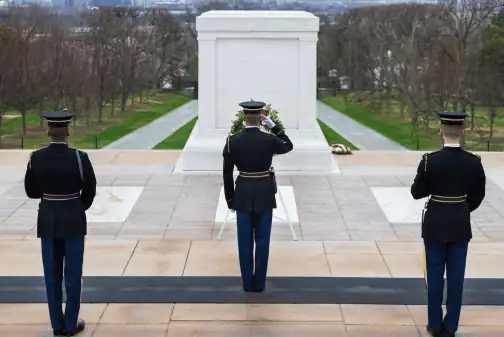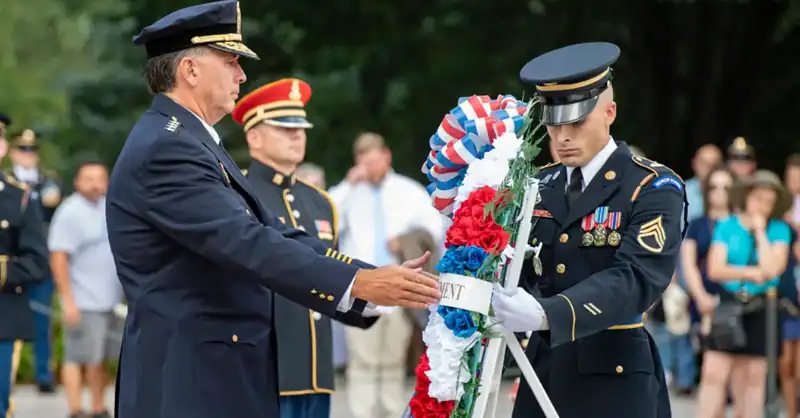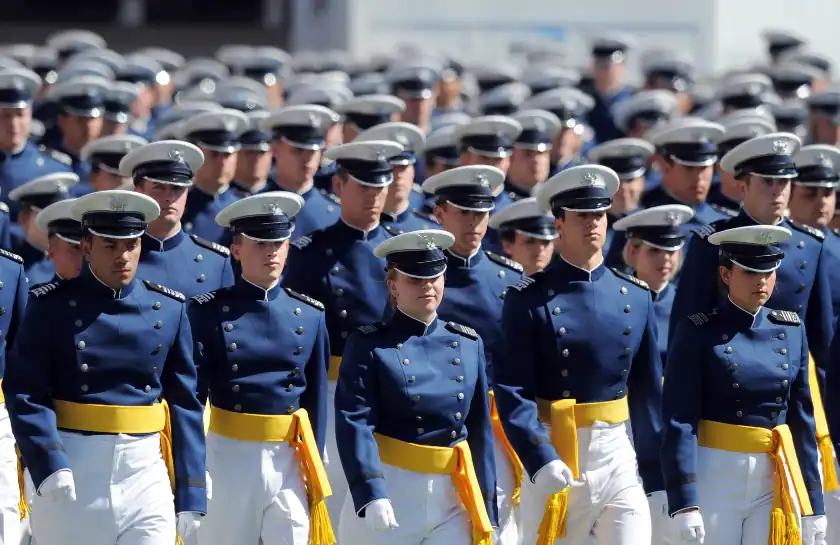Have you ever wondered how much the soldiers who guard the Tomb of the Unknown Soldier earn? The Tomb of the Unknown Soldier is a sacred monument that honors the fallen heroes of the United States who could not be identified.
Located at Arlington National Cemetery, It is guarded by a select group of soldiers from the 3rd US Infantry Regiment, also known as the Old Guard. These soldiers are called Tomb Sentinels, and they perform a solemn and precise ceremony every hour of every day, regardless of the weather or the situation.
But how much do these Tomb Sentinels earn for their service? What are the requirements and the training process to become one of them? And what are the benefits and challenges of guarding the Tomb of the Unknown Soldier?
In this blog post, I will answer these questions with facts and figures from reliable sources.
How Much Do Tomb Sentinels Earn?

You might think that the Tomb Sentinels get paid a lot for their hard work and sacrifice. But the truth is, their salary is not that different from other soldiers in the Army.
According to the official website of the Old Guard, the Tomb of the Unknown Soldier Guard Salary is based on the rank and time in service of the soldier. The average rank of a Tomb Sentinel is E-5 (Sergeant), and the average time in service is 3 years.
The salary of a Tomb Sentinel depends on their rank and their years of service in the Army. According to the 2024 military pay chart, the basic pay for an E-4 (Specialist or Corporal) with less than two years of service is $2,262.60 per month, while the basic pay for an E-6 (Staff Sergeant) with over six years of service is $3,306.90 per month.
However, this is not the only source of income for a Tomb Sentinel. They also receive:
- Basic Allowance for Housing (BAH), which varies depending on the location and the family status of the soldier. For example, the BAH for a single E-4 in Arlington, VA is $2,067 per month, while the BAH for a married E-6 in Arlington, VA is $2,664 per month.
- Basic Allowance for Subsistence (BAS), which is a fixed amount of $386.50 per month for enlisted soldiers.
- Special Duty Assignment Pay (SDAP), which is an additional pay for soldiers who perform duties that are extremely difficult, demanding, or involve an unusual degree of responsibility. The SDAP for a Tomb Sentinel is $300 per month.
- Clothing Allowance, which is a yearly amount of $444.72 for enlisted soldiers to replace and maintain their uniforms.
Therefore, the total monthly income for a Tomb Sentinel can range from $4,500 to $6,000 and $54,000 to $72,000 annually, depending on their rank and their situation. This does not include other possible benefits, such as health care, education, retirement, and tax advantages.
The Benefits and Perks of Being a Tomb Guard

The role of a Tomb Guard at the Tomb of the Unknown Soldier goes beyond monetary compensation. There are several benefits and perks associated with this prestigious position that enrich the lives of the guards.
One significant intangible benefit of being a Tomb Guard is the sense of pride and honor that comes with representing the fallen soldiers and preserving their memory. These guards are entrusted with a sacred duty that carries great weight and significance.
They become part of a tradition of deep respect and reverence that has been upheld for decades. Additionally, serving as a Tomb Guard provides unique opportunities for personal and professional development.
The rigorous training and demanding standards required to fulfill this role instill qualities such as discipline, resilience, and attention to detail. These skills are not only valuable in the military but also transferable to other areas of life.
Furthermore, the bonds formed among the guards are lasting and profound. Working closely together, they develop a strong camaraderie and sense of brotherhood.
The shared experience of guarding the Tomb of the Unknown Soldier creates a unique connection that transcends the boundaries of rank and service.
Other benefits:
- Being part of a tradition that dates back to 1921, and honoring the sacrifice of the unknown soldiers and their families.
- Being recognized and respected by the public, the military, and the government for their service.
- Having the opportunity to meet and interact with dignitaries, celebrities, and veterans who visit the Tomb of the Unknown Soldier.
- Having the opportunity to advance their career and education, as many Tomb Sentinels go on to become leaders and instructors in the military or pursue higher degrees in civilian life.
What are the Requirements and Training to Become a Tomb Sentinel?

You might think that anyone can become a Tomb Sentinel, as long as they are willing to do it. But the truth is, becoming a Tomb Sentinel is one of the most difficult and demanding tasks in the Army.
To become a Tomb Sentinel, a soldier must meet several requirements and undergo a rigorous training program. Some of the requirements are:
- Be a volunteer from the Old Guard.
- Be between 5 feet 10 inches and 6 feet 4 inches tall for males, or 5 feet 8 inches and 6 feet 2 inches tall for females.
- Have a clean military record, with no Article 15s or court martials.
- Pass a physical fitness test, a height and weight screening, and a drug test.
- Commit to serve at the Tomb of the Unknown Soldier for at least 18 months.
Also Read: How Much Does Dry Cleaning Cost of Different Dresses
The training program consists of four phases, each lasting about a month. The phases are:
Phase 1:
Learn the history of the Tomb of the Unknown Soldier and Arlington National Cemetery, memorize the names and locations of the 300 Medal of Honor recipients buried in the cemetery, and study the general orders and standards of the Tomb Guard.
Phase 2:
Learn the manual of arms, the 21-step walk, the changing of the guard ceremony, and the uniform preparation. Practice for hours on the mat, and pass several inspections and tests.
Phase 3:
Learn the outside performance, which includes the wreath-laying ceremony, the request to visit the Tomb, and the response to visitors. Perform several walks on the plaza, and pass more inspections and tests.
Phase 4:
Perform the guard duty under the supervision of a senior Tomb Sentinel. Complete a final test, which consists of a written exam, an oral exam, a uniform inspection, and a performance test. Earn the Tomb of the Unknown Soldier Guard Identification Badge.
Some More Questions You Might Have
What is the Tomb of the Unknown Soldier?
The Tomb of the Unknown Soldier is a place where we remember and honor the soldiers who gave their lives for our country, but we don’t know their names or where they came from. They fought in World War I, World War II, and the Korean War.
The tomb is in Arlington National Cemetery, and it has been guarded by the 3rd U.S. Infantry Regiment, also called The Old Guard, since 1948.
How much money do the guards at the Tomb of the Unknown Soldier make?
The guards at the Tomb of the Unknown Soldier get paid the same as any other soldier in the U.S. Army, based on their rank and how long they have been in the service.
But they also get some extra money for doing this special duty, such as extra pay for working in hard conditions, extra money for buying and maintaining their uniforms, and extra money for living in or near Washington, DC.
The exact amount of money they make depends on many things, but it can be anywhere from $55,000 to $70,000 a year.
What do the guards at the Tomb of the Unknown Soldier do?
The guards at the Tomb of the Unknown Soldier do one thing: they guard the tomb. They do this every day and every night, no matter what the weather is like. They walk back and forth on a black mat in front of the tomb, following a special pattern of 21 steps, 21 seconds, and 21-gun salute.
These numbers mean the highest respect and honor for the unknown soldiers. They also change the guard every half hour during the day and every hour at night, in a very formal and respectful way.
They also take part in ceremonies where they lay wreaths on the tomb or welcome important visitors to the tomb. They always act with the highest standards of appearance, conduct, and performance.
How do the guards take turns? Do they work for 8 hours straight?
No, they don’t work for 8 hours straight. They work in teams of three, and each team has a different schedule. They work for one day, then rest for one day, then work for another day, then rest for four days.
But even when they are not working, they have to get ready for the next shift. They have to make sure their uniform is perfect, practice their skills, and get their hair cut.
Why do the guards wet their gloves?
They wet their gloves to make it easier to hold the rifle. The rifle is very important for the guard, because it shows respect and protection for the unknowns.
My Final Say
The Tomb of the Unknown Soldier Guard Salary is not the main motivation for the soldiers who choose to become Tomb Sentinels. They do it for the honor, the pride, and the duty of guarding the unknowns who gave their lives for their country.
They do it for the challenge, the growth, and the achievement of becoming the best of the best. They do it for the legacy, the history, and the future of preserving the sacred monument that symbolizes the values and ideals of the United States.
If you are considering a career as a Tomb Guard, I encourage you to continue your research and reach out to more relevant channels for more information since this post is mainly about the salary of Tomb of the Unknown Soldier Guard.
The journey may be challenging, but the rewards are immeasurable. Join the ranks of those who honor the fallen and become a part of a tradition that will forever be etched in history.
Thank you for reading this blog post. I hope you found it informative and interesting. If you have any questions or comments, please feel free to leave them below.
I would love to hear from you. And remember, the Tomb of the Unknown Soldier is not just a monument, it is a symbol of the nation.

Joseph Michael is the founder and editor of CostCheckr.com, a website that helps you find out how much things cost in different situations. He has a degree in economics and statistics, and he uses various data sources and methods to produce reliable and informative content for you. He loves to travel, play cricket, read books and study about economics and statistics.

